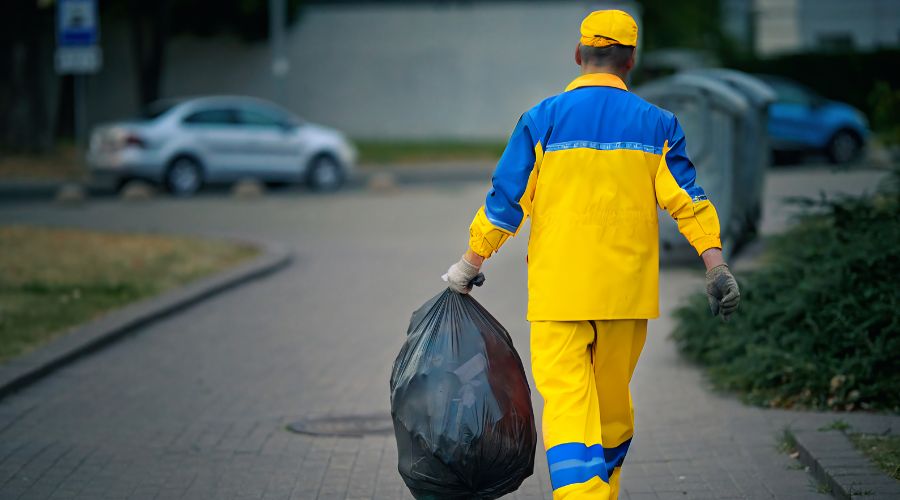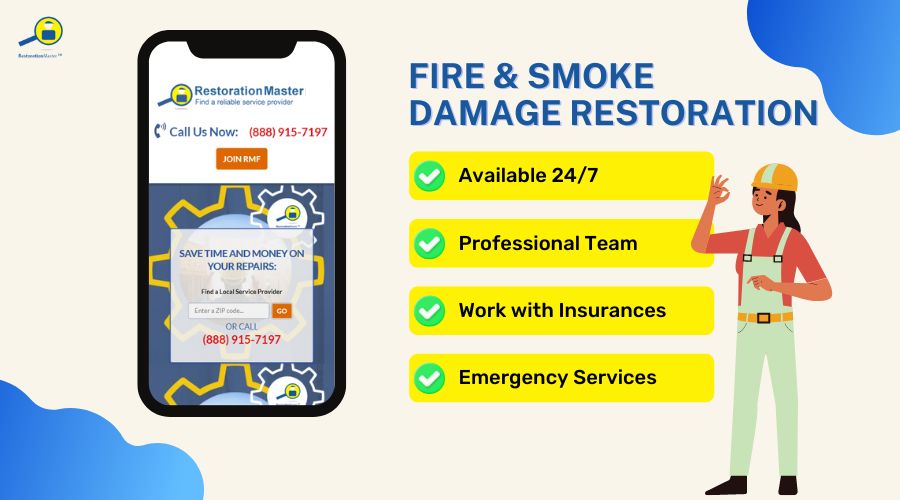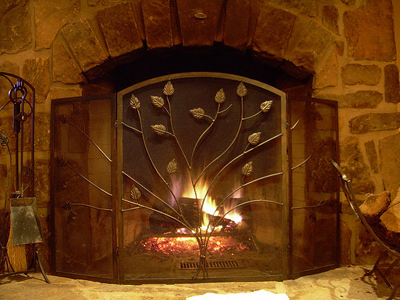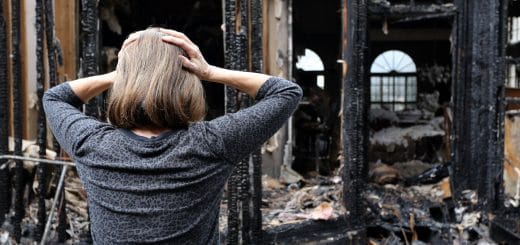What to Throw Away After Smoke Damage?
Key Highlights:
- PorousPorous describes a material that contains small openings or ... More materials: Mattresses, upholstered furniture, carpets that absorb smoke smell
- Cosmetics, toiletries, and medications that get contaminated
- Burnt clothing, linen and textiles
- Perishable food items that were kept open.
- Electronics
- Anything that is severely damaged

A house fire is a devastating event where extensive property damage occurs. Homeowners expect to feel relief once the flames are extinguished. However, it’s only the beginning of the restorationRestoration is the process of returning a property to its pr... More process, which includes throwing away unsalvageableUnsalvageable items or materials are too damaged, contaminat... More possessions affected by smoke damage.
What is smoke?
A byproduct of fire, smoke at first glance appears harmless. After all, a fire is what causes the most significant property damage. However, the destructive power of smoke shouldn’t be underestimated. Wafting stealthily through the air, it causes damage to things without being seen.
A collection of tiny particles, smoke develops when the fire fails to consume particular materials. As a result, the microscopic particles float into the air as smoke. The chemical makeup of smoke depends on the fuel source, in other words, the material that is being burned.
How does smoke affect a home’s contents?
Various materials can produce particles containing hazardous chemicals, such as carbon monoxide, hydrogen, ammonia, sulfur dioxide, or formaldehyde. Due to these potentially dangerous chemicals, it is a health risk to inhale smoke in a burning building. When smoke covers belongings, danger is present.
A health hazard develops when the home’s occupants are exposed to smoke-damaged items for any length of time. While it may be tempting to avoid disposing of these ruined possessions, especially costly ones, it can result in more harm than good.
Smoke tends to embed in soft, porousPorous describes a material that contains small openings or ... More materials, making it nearly impossible to get out. Avoiding ongoing exposure to the hazardous chemicals in smoke is the primary reason it is recommended that homeowners throw out the following possessions after smoke damage.
Carpets
Made of porousPorous describes a material that contains small openings or ... More, soft fibers, carpets trap smoke particles. While the carpeting may appear undamaged, it is likely to harbor the foul smell of smoke. Plus, fire hoses will have drenched the carpet, making it prone to moldMold is a type of fungus that grows in damp or humid conditi... More growth. The fire’s heat also causes the carpets to absorb harsh chemicals.
Medicine
Homeowners who spend money on medications are unwilling to throw them away after a fire. Medicines are unsalvageableUnsalvageable items or materials are too damaged, contaminat... More once damaged by smoke, as the heat from the fire alters the composition of the ingredients. Also discard over-the-counter drugs, like pain relievers and cough suppressants.
Cosmetics
Another pricey product, makeup should be tossed after exposure to smoke damage. Smoke seeps into the cosmetics and toiletries, contaminating them with harsh chemicals. A fire’s high temperature also changes the makeup’s composition. It’s unwise to apply contaminated cosmetics to the skin and eyes.
Nonperishable Food
Foods sealed in glass jars or aluminum cans should be discarded. The smoke damage and toxic fumes can penetrate through the containers, even ones left unopened. The high heat of the fire alters the composition of certain foods and activates harmful bacteria, making them unsafe to eat.
Food that spoils upon exposure to the high heat can make a person sick. Whether the food is sealed or unsealed, throw it out upon suspecting it may have come into contact with smoke. Rusted, bulging, or charred cans are clear signs that the food should be thrown away.
Refrigerated Food
If smoke penetrated the fridge, it is advised to throw out all food inside. Homeowners can test whether smoke affected the appliance by checking for a smoky smell upon opening it. Furthermore, visible signs of sootSoot is fine black particles composed of carbon and other ma... More covering food are indications that it is compromised and shouldn’t be eaten.
The fridge may have lost power during the fire. If the food inside has been left inside for two hours or more at a temperature above 40 degrees Fahrenheit, throw it out. Perishable items that release an odorAn odor is a smell, often detectable by the human nose, whic... More and freezer foods that no longer feel frozen should not be consumed.
Clothing
Smoke particles easily travel throughout the home, entering bedrooms, closets, and drawers. Like carpeting, clothing is made of soft materials that trap smoke. Even if the fire blazed far from the clothing items, they may not be safe from the harmful effects of smoke damage.
Any burnt clothing items should be thrown away. Use good judgment when evaluating children’s clothing that has been exposed to smoke damage. Some clothing pieces may be salvageable by properly cleaning and disinfecting them in a rinse of tri-sodium phosphate, bleach, and water.
Some Electronic Items
Smoke can easily damage your electronics and can burn the wires, sockets or adapters. It is recommended to throw away phone chargers, batteries and small kitchen electronics as it can cause further deterioration and short circuits.
What Items Can be Repaired and Reused After Smoke?
Thankfully there are some things that can be salvaged. Smoke damage restoration professionals can help you restore and salvage these items as a part of our fire damage restorationFire damage restoration is the process of repairing and rest... More and content cleaning process. Here’s a concrete list of items that can be saved.
- Walls: Professionals can help you remove smoke and sootSoot is fine black particles composed of carbon and other ma... More stains from the wall. Unless if it is in a very bad condition, then it needs to be replaced.
- Glass: Anything with glass can easily be restored since it is resistant to fire
- Metal: Metal can withstand higher temperatures without igniting. Compared to other materials like wood or plastic, it is resistant to smoke and fire.
- Hardwood Floors: Professionals can easily salvage hardwood floors and repairRepair is the act of fixing or restoring damaged property, m... More them unless if there is any extreme condition that it has to be replaced.
Read: How to clean burnt marks from walls and kitchen cabinets?
Is it safe to use dishes after a house fire?
Smoke tends to disfavor nonporous surfaces, like hardwood floors, dishes, and cookware. Glass and ceramic dishware, even when covered in sootSoot is fine black particles composed of carbon and other ma... More, are generally safe to reuse. Most metal cookware is designed to withstand high temperatures and, with minor smoke damage, should be reusable.
The reason hard items, like dishes, are safe to use after smoke damage is that they don’t absorb the dangerous chemicals present in smoke particles. Smoke particles cannot embed in nonporous materials. After the fire, simply clean the dishes to remove the smoke and reuse.
Call RestorationMaster For Fire & Smoke Damage Restoration

When a fire event occurs in your home, call the fire officials to put out the flames. Once the flames are extinguished, immediately consult a reputable fire damage restoration company to stop the spread of fire and smoke damage.
Skilled fire restorationRestoration is the process of returning a property to its pr... More technicians arrive promptly to secure the fire-damaged property. They board up windows and doors to prevent vandalism and water intrusion from the elements like rain and hail. A thorough assessment is performed to determine the extent of fire damage.
Water likely entered the home through the fire extinguisher process. Fire damage cleanup specialists extract the excess moisture and dry the area to prevent moldMold is a type of fungus that grows in damp or humid conditi... More infestations from developing. Content cleaning is performed on damaged goods, such as furniture and personal belongings.
Water damage cleanup involves running powerful air-scrubbers and using advanced techniques that dislodge the sootSoot is fine black particles composed of carbon and other ma... More and smoke from affected materials, such as ceilings, walls, and possessions. Once the cleanup is completed, technicians deodorize the space to remove the unpleasant smoke odors.












